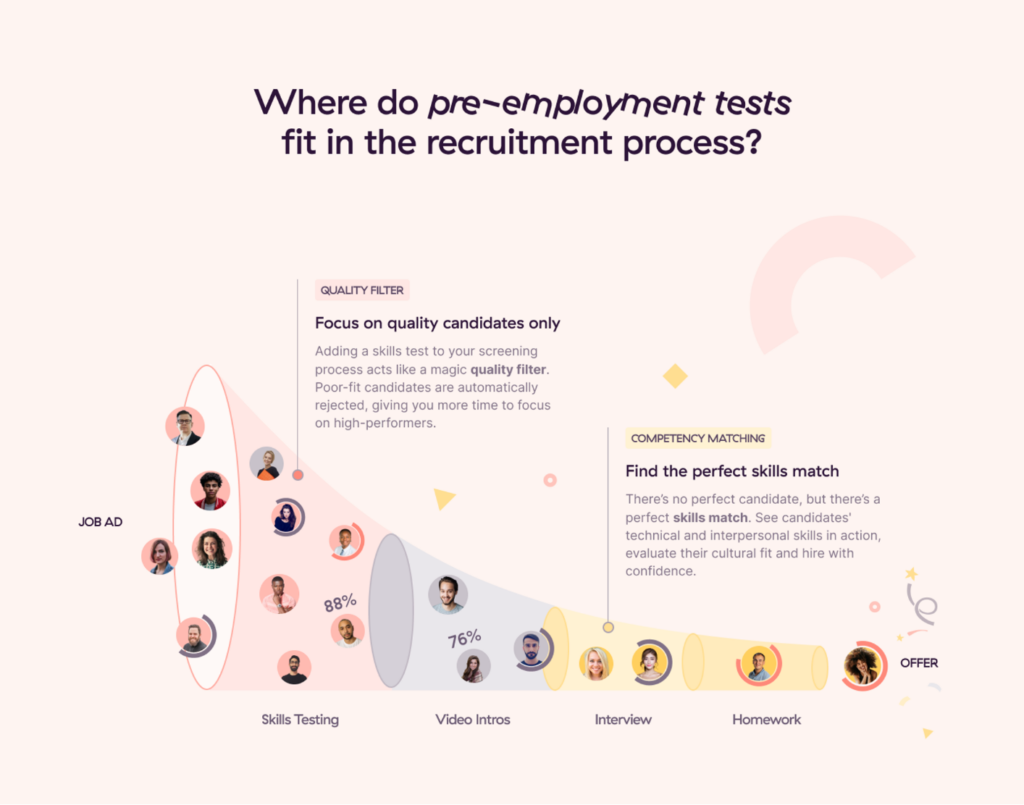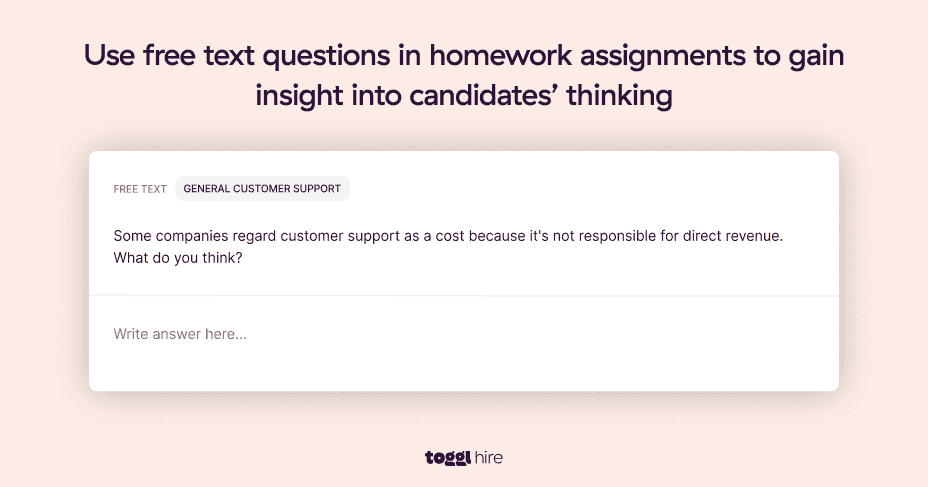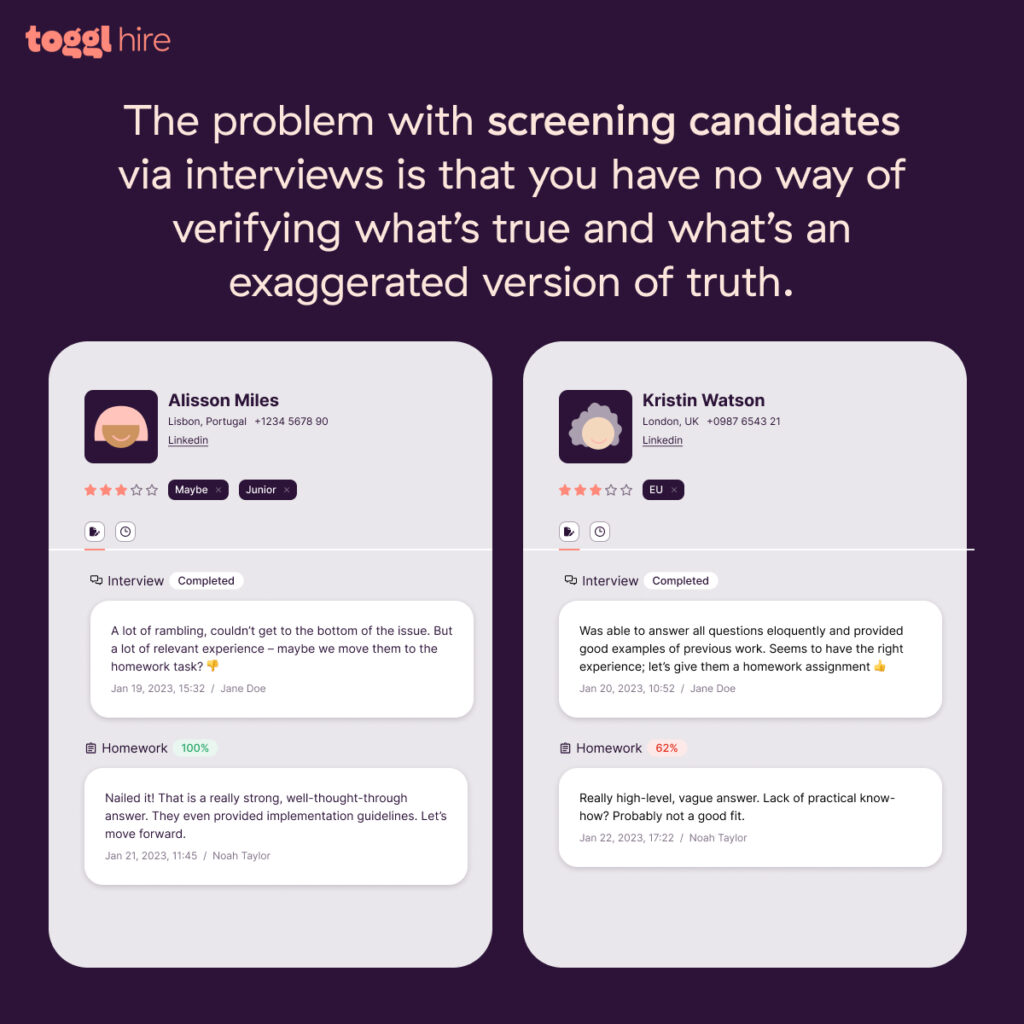Hiring takes time and consideration, and while it might seem like a lot of work, careless recruitment can quickly (and negatively) cascade through an organization. Productivity dips, teams fail to gel, and the promotion pipeline from entry-level to executive freezes.
All this is avoidable with a systematic and strategic candidate selection process. A finely honed selection process reduces employee turnover and promotes a cohesive company culture. Well-chosen workers are ready to rise and perfectly fit their roles — all great things.
Few companies looking for a competitive advantage can overlook these benefits, especially in a cut-throat hiring market. And there is always room for improvement. If you’re struggling, here are a few of our own tips for creating a candidate selection process that lands the brightest talent.
TL;DR — Key Takeaways
The employee selection process involves sourcing, assessing, and selecting candidates for roles. Getting this process right is important, as a streamlined selection process aids employee retention, supplements full-cycle recruiting strategies, and builds a more robust company culture.
Employee selection typically follows a standard flow. Hiring teams start sourcing candidates and screen applicants before scheduling in-person interviews and aptitude testing. Recruiters shortlist candidates, carry out background and reference checks, and make a job offer applicants cannot refuse.
Traditional employee selection methods are rapidly becoming outdated. Digital selection tools modernize the selection process by refining job descriptions, automating screening, and predicting job performance.
Skills testing is a critical part of modernizing the employee selection process. Toggl Hire’s skills tests replace screening interviews and reduce recruiter bias. This kind of testing supplements interviews, delivering neutral insights into candidate skills.

What is the employee selection process?
The employee selection process includes the seven steps of the hiring cycle, from advertising a job to making an offer. A lot happens between each step, though, with each presenting challenges and opportunities to filter candidates and find the right hire.
Something most recruiters fail to understand is that the seven-stage model doesn’t have to be rigid. Sometimes, hiring former colleagues or trusted freelancers is the right solution, even though it doesn’t fit neatly into this model.
However, the classic format below still serves as a handy starting point:
Create a robust job description and announce it on job boards and ads
Pre-screen job seekers by looking at their CVs and cover letter
Conduct an initial screening process for the best applicants, usually by telephone interview
Set up in-person interviews for the best candidates
Shortlist top talent with feedback from the hiring manager
Check the candidate’s references, qualifications, background, and anything else
Finally, secure the best candidate with a job offer!
None of this should sound unfamiliar to veteran hiring managers. The traditional employee selection process is simple and easy to understand. However, parts of the process are quickly becoming outdated (specifically the cover letter and resume part — more on that later, though).
The point to remember is that, like everything else in life, recruitment methods and techniques evolve. While the recruitment process looks familiar, the best practices associated with each step are evolving. Technology like skills testing and artificial intelligence are reshaping how we select candidates.

Exploring each stage of the recruitment and selection process
Every stage in the recruiting process matters. Some steps require more time and resources, but you should approach each step with the same care and attention.
We recommend auditing each step when working to improve your recruitment process. Think about whether you’re excluding candidates unconsciously at any stage. Are promising candidates dropping out? Are you filtering the best candidates for each role, or just “good” candidates without proper testing?
We’ll explain how to improve your practices throughout the employee selection pipeline. With luck, you’re almost there already. If not, these tips are for you…
1. Application
At the start of the hiring process, companies usually create job descriptions, weave them into job ads, and hope the job ad delivers a batch of prospective hires. Most recruiters use a trusted set of job platforms or publications and reuse the same description format for multiple roles.
While somewhat simple and quick to implement, this standard approach has several challenges:
The job description may sound great to internal readers but fails to attract strong applicants
Applicants may not suit the advertised role, ruining the entire selection process
Job ads, application forms, and descriptions can actively alienate readers and limit your talent pool
Ads may be poorly placed, limiting their reach
Writing an appealing and accurate job description is important if you actually want to source candidates with the skills you need. Here are some quick tips to help you do so:
Write detailed job descriptions. Vague language leads to an influx of unsuitable applicants. Tell applicants what the job entails and the skills the ideal hire needs.
Avoid long-winded texts. Write a novel, and candidates are sure to zone out. Additionally, too much detail about job requirements can also put off strong candidates who may not possess every single qualification or quality.
Try to avoid requesting formal qualifications if possible. Sometimes, advanced degrees are non-negotiable. Typically, though, as long as someone has the right skills, they can do just as well as someone with a strong academic background (or even better!).
Use inclusive language and enlist diverse members of staff to proofread descriptions. Job description language should be neutral and suitable for all audiences. For example, avoid masculine-sounding terms or specific cultural references.
How should you modernize the candidate sourcing phase?
Start by focusing your sourcing strategy on the skills roles require. Qualifications or experience still matter. However, customized skills testing lets you assess applicants for skills they need on the job. Many companies find test results a more useful hiring metric than the details on traditional resumes.
Using qualifying questions at the start of the application process also helps. Ask all applicants two or three questions about skills essential to the role. For instance, you might ask whether the applicant has experience with PowerPoint or SQL databases.
You’ll also want to ensure you’re posting your job ads in the correct places. Look for specialist online job boards for every role. For example, Crunchboard is a great option when seeking developers or engineers.
Social media platforms are also worth considering. Posts about job openings can attract passive candidates who don’t hang around job boards. Some candidates only notice ads on Twitter or Facebook. It all depends on where your audience is.
2. Resume screening
Paper may have lost out to digital formats, but hiring managers must still sift through resumes and eliminate unsuitable applicants.
Screening is both labor-intensive and vital. You can’t hire successfully without resume screening, but screening is rarely a thrilling experience for a hiring team. Common challenges linked to screening resumes include:
Dedicating sufficient attention to each applicant. While that’s not usually the root problem, doing so without wasting time and resources is.
Setting the wrong basic requirements. Recruiters who don’t know what they’re looking for tend to advance poor-quality candidates who eventually leave because of a skills mismatch.
Being too restrictive. Recruiters often focus too much on specific role requirements. This leads them to exclude or miss good hires before they can prove their capabilities.
Only waving through candidates with strong resumes. To be honest, that’s such a cop-out. Candidates with seemingly weaker qualifications or experience may show promise after you look at other factors, such as their unique skill set or skills assessment results.
Badly executed resume screening delivers the wrong candidates for interviews and skill assessments and wastes significant time — a double whammy no hiring manager can afford.

To modernize your resume screening process, use the right resume screening tools.
Recruiting software screens resumes for basic information, removing the stack of dead-end applications from unqualified candidates. Couple automated screening with basic skills tests. Toggl Hire, for example, enables you to administer a simplified screening test to all job seekers.
Tests assess fundamental skills related to the role and help you identify candidates without super-strong resumes who have impressive underlying skills. Assessments also screen out casual applicants who refuse to take the test.
3. Screening call
Screening calls allow you to quickly chat with interesting applicants. Typically, hiring team members use a few targeted questions to assess whether the candidate should proceed to the interview stage or further assessments.
Again, while simple enough, challenges associated with screening calls include:
Not asking the right questions. Targeted questions make it much easier to go deeper during a brief phone interview, helping you glean insights about the candidate’s personality and soft skills.
Extracting valuable information. As a phone interviewer, you don’t have much time. Interviews should be focused, with a clear structure and the definition of suitable candidates in mind.
Relying only on phone screening. Depending on the role you’re hiring for, a phone screen alone might not be enough to figure out whether a candidate should advance to the next stage. You can screen candidates via video calls (although this raises bias issues, so be careful). Skills assessments and email also enable efficient screening.
Using phone interviews isn’t inherently ‘wrong.’ However, we suggest leveraging other tools to effectively vet potential employees.
Add an interactive element by using homework assessments to simulate on-the-job tasks. They don’t need to take hours — a simple 30-60 minute task is enough to assess employee strengths and weaknesses.

Ultimately, we recommend focusing on assessing relevant skills, regardless of how you do it, as it helps reduce recruiting bias. Conversations via phone or video may be unavoidable, but they are vulnerable to recruiter bias. Digital tools work around bias, making employee selection more neutral.
4. Assessment test
Assessment tests typically come before formal interviews (but shouldn’t replace them entirely) and help hiring teams verify that candidates possess the correct skills — at least the most basic or important ones.
Challenges at this stage of the selection process include:
Understanding critical skills for each role. Every role is different, but each role likely has a few standout skills that, if the candidate doesn’t possess them, will make it very hard to succeed. Figure out what those are.
Choosing the right depth and scope. Avoid 2-3 hour tests, but ensure the assessment is long enough to get a good idea of someone’s skills. The same applies to homework tasks. Set sensible timescales, encouraging candidates to work quickly without putting them under too much pressure.
Not being too rigid. Sometimes, assessing skills isn’t about getting the “right” answer. High scores matter, but how candidates approach tasks and their own questions can also influence recruitment decisions.
As a skills testing and hiring platform, the best recommendation we can make is to use professional skills tests instead of going it alone. You know the ins and outs of every role, but you don’t necessarily know how to assess skills connected with the role.
Skills assessment companies offer tailored digital tests and homework assignments for every situation. For instance, the Toggl Hire skills test library is full of expert-curated tests for hard and soft skills. This helps with quality control and reduces assessment costs.
It’s also helpful to mix technical assessments with tests for soft skills like cultural or cognitive abilities. Testing Python coding is great. Coupling coding tests with problem-solving assessments is even better.
Automate this process as much as possible! Candidate assessment tools like Toggl Hire automatically collect and grade responses. Using the candidate pipeline, you can also automatically schedule follow-up interviews and even deliver individualized feedback for failed candidates.
5. In-person interviewing
At this stage in the process, recruiters often schedule multiple interview rounds, depending on the number of remaining applicants.
During this step, interview panels grade answers and candidate qualities. Candidate shortlisting helps narrow the list before a final hiring manager or committee makes the hiring decision.
Common pitfalls here include:
A lack of structure or consistency in the interview process leads to a lack of objectivity and unfair outcomes
Asking irrelevant or inappropriate questions leads to discrimination and the exclusion of qualified candidates
Focusing too much on surface-level factors like body language or presentation instead of concrete skills
Too many rounds of interviews dissuade candidates from joining your company
Interview panels that lack diversity or specialist expertise can result in ill-informed or biased decisions.
If you’re struggling here, a structured interview process is your key to getting this step right. A structured interview uses a standard interview script to ensure objective assessment processes for every candidate.
During a structured interview, you typically use strategic interview questions to explore how a candidate’s work history and skills translate into future performance. Combine behavioral, situational, and role-related questions. Assess soft skills and cultural fit while delving into the technical capabilities your post demands.

Don’t rely on time-pressed hiring managers to remember the details of each interview. Instead, use interview scorecards to grade applicants. Because each interviewer uses the same metrics, you’re guaranteed more objective outputs from each interview.
6. Background checks
At this stage, HR teams must check shortlisted candidates to ensure their credentials are accurate. While skills testing is a great way to ensure someone can walk the walk, you might need to add additional checks and measures depending on the role.
For instance, if the role requires giving someone access to confidential information, background checks should detect previous instances of unsafe data use or information disclosure. Or, if you’re hiring someone to work with children, they might require a background check for safety reasons.
The biggest obstacle here is learning how to balance information discovery and personal privacy. For example, criminal record checks or drug testing may be necessary, but requesting access to someone’s credit score is probably totally unnecessary.
Companies often see background and reference checks as indispensable, but there are other ways to reach the same conclusion.
At Toggl, for example, we prefer to invite the best candidates to a paid test week. During the week, we assess soft and technical skills, model job tasks, and allow managers to get to know top candidates. This provides us with a rich portrait of who the candidates are and how they will perform.

7. Reference checks
After narrowing down their shortlists to a few suitable candidates, the penultimate stage in the selection process involves reference checks.
Checking references may sound simple, but it somehow always seems to create more than a few headaches for HR managers, typically for the following reasons:
Ensuring referees are genuine. Candidates may supply friends as referees, resulting in “fake” testimonials that carry zero weight.
Interpreting references fairly. Not everyone has access to great references, whether because they have little job history or for other reasons (maybe their last workplace was truly toxic, or there was a miscommunication regarding expectations that’s simple enough to explain).
Extracting relevant information from references. Recruiters must ask the correct questions when requesting references. Ask for role-related feedback — not general comments.
Reference checks are becoming less relevant these days as companies have better ways to assess a candidate’s previous job performance.
Instead of relying on references, leverage skills tests to verify candidate skills. High scores on role-related skill tests are better indicators of future performance than an out-of-date reference from someone they worked with five years ago.
You might also use psychometric or personality tests to assess candidate qualities. Professionally designed personality tests provide robust evidence of reliability and integrity. They are also objective, assessing every candidate with the same tools — not a random group of previous colleagues.
Tip: If you stick with old-school references, streamline the process with digital tools. Services like Xref automate reference requests and create reports about their previous experience.
8. Decision and job offer
In an ideal world, you find the perfect new hire, make an offer, and the candidate accepts immediately. If the hiring process does its job, new employees will be up and running in days. If not, employees struggle and (eventually) leave.
Nobody wants to return to step one, at least not immediately. That’s what makes this stage of the hiring process so critical. It’s your one chance to reassess candidates and make the right hiring decision. Challenges at the final stage include:
Offering a great salary and benefits package. Often, companies fail to meet candidate expectations regarding salary and benefits, especially if it’s not listed on the job ad (which it should be!).
Weak employer branding that scares off potential hires. The best hires are in demand. They have many options and tend to choose confident, positive brands. If your employer brand comes across poorly, candidates are likely to look elsewhere.
Being too hasty. You need to ensure every new hire is enthusiastic and well-suited to their role. While you don’t want to draw the hiring process out too long, it’s fair to let a few of the final candidates know you’re still making a decision.
To get this stage right, be fair and flexible. For example, a one-size-fits-all benefits package doesn’t suit a flexible, diverse workforce. Try to offer bespoke benefits and working hours to fit the lifestyles of top employees.
As part of this, research competitive salaries for each role. Candidates have likely already done this, and lowballing the average is a bad look. Use salary benchmarking tools like PayScale or Salary.com or browse similar listings on sites like Glassdoor to get the numbers right.
If the right candidate declines your offer, it’s time for some introspection. Audit your job descriptions and employer value proposition. Ensure descriptions detail benefits and avoid springing surprises at the end of the hiring process.
Improve your hiring process with Toggl Hire
A lazy or outdated recruiting process often leads to high employee turnover, costly rehires, and a chaotic business culture. And with some many digital tools at your disposal, there’s no reason to let your selection process get so out of hand.
The best tool? We’re a bit biased, but we suggest using Toggl Hire to simplify and modernize the hiring process. Our full-cycle recruitment software can help with nearly every stage.
Use it to create a personalized candidate pipeline for each role, integrating sourcing, assessments, interviews, and more. Then, browse our skills test library, which includes expertly crafted assessments for common (and not-so-common) technical skills alongside personal qualities and abilities.
Our tools make it easy to customize selection processes, assess the skills you need for every role, remove sources of bias, and guarantee a smooth candidate experience.
To find out more, create a free account and give Toggl Hire a try.

Elizabeth is an experienced entrepreneur, writer, and content marketer. She has nine years of experience helping grow businesses, including two of her own, and shares Toggl's mission of challenging traditional beliefs about what building a successful business looks like.








